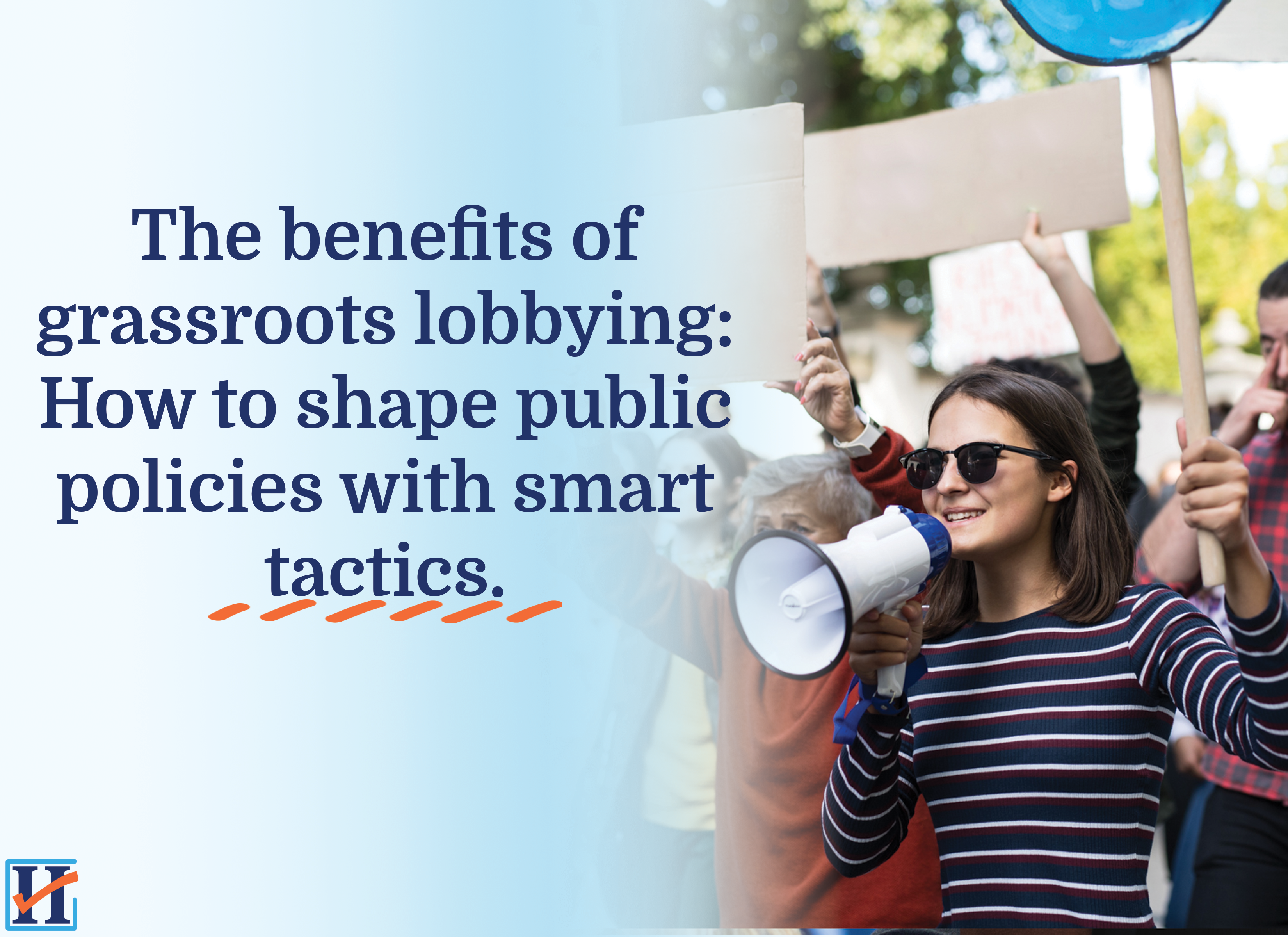Grassroots lobbying effectively influences legislation and decision-making by rallying the public to contact legislators and government officials about specific issues. When used correctly, it can significantly affect shaping public opinion and pushing changes societies need.
Today we want to share information on how grassroots lobbying works, including its potential, advantages, and how to use it successfully in your campaigns.
Let’s dig in.
What is grassroots lobbying?
Grassroots lobbying, also referred to as indirect lobbying, is a method that involves generating political interest in particular communities and encouraging the general public to contact legislators and government officials about a given issue.
This is distinct from direct lobbying, where organizations communicate their stance on issues directly to lawmakers and government officials. Grassroots lobbying aims to affect legislation by mobilizing the public, garnering support for a cause and ultimately influencing policy decisions in favor of the public’s interests.
Whatever campaign you are running, you must consider your resources, such as staff, volunteers, budgets, digital and offline channel presence, field tactics and the tools to implement them. Typically, campaigns use a mix of phone calling and SMS texting tools, and HubDialer allows organizations to kick off their outreach efforts smoothly and effortlessly. While our texting tools are about to be released, check the affordable call pricing options for all campaign types.
What are the benefits of grassroots lobbying?
Grassroots lobbying offers several advantages, making it a practical approach to influencing legislation and decision-making processes. Some of the key benefits include:
- Increased public support: Grassroots lobbying engages the public in decision-making, increasing support for an organization’s cause among constituents.
- Representation of minority voices: Grassroots lobbying helps represent the viewpoints of minority groups, ensuring that their concerns are heard and addressed in the decision-making process.
- Education: By providing information and resources on complex issues, grassroots lobbying educates the public and lawmakers, leading to more informed policy decisions.
- Community mobilization and organization: Grassroots lobbying focuses on mobilizing and organizing people directly impacted by the issue, encouraging them to take action and contact their legislators.
- Community engagement: Grassroots lobbying involves stimulating the politics of specific communities, which leads to stronger connections between the public and the decision-making process.

What is the difference between grassroots lobbying and direct lobbying?
Grassroots and direct lobbying are two distinct approaches to influencing legislation and decision-making.
The goal of the grassroots approach is to mobilize the public, build support for a cause, and impact policy decisions in favor of the public’s interests.
In contrast, direct lobbying involves organizations directly communicating their stance on issues to lawmakers and government officials. This typically involves one-to-one communication between a representative of an interest group and legislators or government representatives to influence policies.
Direct lobbying involves organizations directly relaying their position on issues to lawmakers and government officials.
While direct lobbying can be effective in certain situations, grassroots lobbying offers the advantage of engaging the public, building support for a cause, and ultimately impacting policy decisions in favor of the public’s interests.
Is grassroots lobbying legal?
Grassroots lobbying is legal but subject to specific regulations and restrictions, especially for nonprofit organizations.
For example, organizations exempt from taxation under section 501(c)(3) of the Internal Revenue Code are subject to stringent restrictions on the amount of lobbying activity they may engage in, including direct and grassroots lobbying. At the federal level, no more than 25% of lobbying expenses can be expenses for grassroots lobbying activities.
Funding for grassroots lobbying campaigns can come from various sources, such as individual donations, political party committees, and political action committees (PACs).
Various federal and state laws require organizations that fund or participate in grassroots lobbying to disclose their grassroots lobbying activities. A majority of state lobbying disclosure laws define lobbying to include grassroots or “indirect” lobbying.
In some states, you must register and report grassroots lobbying conducted in that state, regardless of whether you are registered for conducting direct lobbying. In other states, grassroots lobbying must be notified only if you are already registered for direct lobbying.
Organizations must be aware of the specific regulations and restrictions that apply to their lobbying activities to ensure compliance with the law.
Why is grassroots lobbying Important?
Grassroots lobbying is essential for several reasons. Here is how it can benefit your campaigns:
- Grassroots lobbying can increase support for an organization’s cause among constituents.
- It allows organizations to present their preferred solutions to the public and lawmakers, increasing the likelihood that these solutions will be enacted.
- Grassroots lobbying empowers individuals to become politically active, giving them a voice in the legislative process and strengthening the organization’s influence.
- Through grassroots lobbying, you represent the viewpoints of minority groups, ensuring that their concerns are heard and addressed in the decision-making process.
- Finally, by providing information and resources on complex issues, grassroots lobbying educates the public and lawmakers, leading to more informed policy decisions.
Those indirect activities should always aim to influence legislation and decision-making processes in favor of the public’s interests.

What is the difference between grassroots lobbying and issue advocacy?
Grassroots lobbying and issue advocacy are two distinct approaches to influencing legislation and decision-making.
As mentioned before, grassroots lobbying encourages the general public to contact legislators and government officials rather than conveying the message to the legislators directly.
On the other hand, issue advocacy refers to communication efforts that focus on broad political or social issues. It aims to bring awareness to a particular problem. It does not persuade the public with electoral outcomes as the focus. Issue advocacy campaigns are usually conducted by issue advocacy groups, interest advocacy groups, issue-only groups, or special interest groups.
How does grassroots lobbying help political organizations?
Grassroots lobbying can benefit political organizations in various ways.
Firstly, it involves engaging the public in the decision-making process, which increases support for the organization’s cause among constituents.
Secondly, it allows organizations to present their preferred solutions to the public and lawmakers, increasing the likelihood that these solutions will be enacted.
Thirdly, grassroots lobbying empowers individuals to become politically active, giving them a voice in the legislative process and strengthening the organization’s influence.
Fourthly, it can help represent the viewpoints of minority groups, ensuring that their concerns are heard and addressed in the decision-making process.
Lastly, by providing information and resources on complex issues, grassroots lobbying can help educate the public and lawmakers, leading to more informed policy decisions.
What are common tactics used in grassroots lobbying campaigns to influence public opinion?
One effective way to influence public opinion is through grassroots lobbying campaigns using different strategies and tactics.
Here are some tactics that political organizations can use to influence policymakers through grassroots lobbying:
- Personalized communication from supporters to the elected officials, as these are more likely to be read and considered.
- Utilization of various channels by employing a mix of communication channels, such as letter writing, phone calls, emails, and social media, to reach out to legislators and government officials.
- Building coalitions with other stakeholders, community leaders, and organizations that share common goals to amplify your message and increase your influence.
- Providing information and resources on complex issues to help educate the public and lawmakers lead to more informed policy decisions.
- Mobilizing supporters and organizing rallies, public meetings, and other events to mobilize supporters and demonstrate public support for your cause.
- Leveraging media, utilizing media outlets, such as newspapers, radio, television, and online platforms, to expand outreach and increase public support for an issue.
- Telling a persuasive story highlights the policy problem’s urgency and most feasible solution.
- Building relationships and networks to establish long-term relationships with policymakers, their staff, and other influencers to increase your organization’s credibility and influence.
As you can see, political organizations too can effectively engage in grassroots lobbying to influence policymakers to achieve their policy goals.
Successful grassroots lobbying campaign examples
Here are some examples of successful grassroots lobbying campaigns that have made a significant impact:
- American Society of Anesthesiologists: This organization grew its grassroots support by building relationships with key influencers and providing resources to help advocates become politically active.
- American Farm Bureau: The American Farm Bureau taught its advocates to tell compelling stories, which helped them effectively communicate their message to legislators and the public.
- Veterans for American Ideals: This group successfully advocated for veterans’ rights by utilizing online advocacy tools and engaging with supporters through social media.
- Land Trust Alliance: The Land Trust Alliance mobilized its supporters to protect land conservation efforts by organizing public meetings, creating educational materials, and leveraging media coverage.
- MADD (Mothers Against Drunk Driving): MADD successfully fixed a flaw in Hawaii’s drunk-driving law through grassroots lobbying, which involved educating the public, mobilizing supporters, and directly contacting legislators.
These examples demonstrate the power of grassroots lobbying in influencing legislation and decision-making processes by mobilizing the public, providing resources, and utilizing various communication channels.

What role do volunteers play in grassroots lobbying campaigns?
Grassroots lobbying campaigns rely heavily on volunteers who form the backbone of grassroots organizing. Volunteers perform various essential tasks to promote the campaign’s message, interact with voters, and mobilize support for the cause.
These tasks include canvassing, which involves going door-to-door in neighbourhoods to distribute campaign materials, speak with voters, and gather support or information.
Phone banking is another common task where volunteers call potential voters to discuss campaign issues, answer queries, and encourage them to vote or participate.
As a volunteer, you can also assist in data entry and organization. You can help organize and enter voter information, campaign events, and outreach efforts into databases or spreadsheets.
Volunteers may also participate in event organization, helping plan and execute rallies, public meetings, and fundraisers to raise awareness and support for the campaign.
Additionally, volunteers can support the campaign’s online presence by creating and sharing content on social media platforms, engaging with supporters, and promoting the campaign’s message.
Closing thoughts
Grassroots lobbying can effectively influence legislation and decision-making by mobilizing the public to contact legislators and government officials regarding specific issues.
Start with understanding the difference between direct and grassroots lobbying. After that, explore the tactics in this article and be aware of legal regulations.
There is really no reason why individuals and organizations can’t effectively use grassroots lobbying in their campaigns to make a difference in their communities and beyond.
